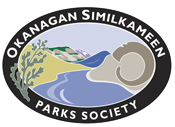Projects
Mike Miller rare plant survey summary
“Three rare plant species were recorded during the survey of Oliver Mt.: Western Stickseed (Lappula occidentalis var. cupulata), Nine-Leaved-Desert-Parsley (Lomatium triternatum ssp. Platycarpum), and Thick-leaved Thelypody (Thelypodium laciniatum var. laciniatum). Western Stickseed (Lappula occidentalis var. cupulata) is red-listed with a provincial ranking of S1. Nine-Leaved-Desert-Parsley is red-listed with a provincial ranking of S2. Thick-leaved Thelypody is blue-listed with a provincial ranking of S2S3. Another red-listed species, Whited’s Halimolobos (Halimolobos whitedii), has previously been reported from Oliver Mt. but was not observed at the reported Conservation Data Centre location during this survey, possibly because it was no longer in flower and hence not easily visible.
Western Stickseed (var. cupulata) (Fig. 1) is an annual herb in the Borage family (Boraginaceae). In Canada, this variety has been recorded from only a few sites in south-central BC. The new Oliver Mt. record is the first documented occurrence from the Oliver area. The next closest records are from Richter Pass west of Osoyoos. At Oliver Mt., Western Stickseed occurs in small scattered patches on mid and upper slopes over an approx. 3 km sq. area. Occupied habitat includes dry gravelly to sandy soil in open grasslands, scree slopes, rock outcroppings, and rock bands within the Antelope Brush community (Fig. 2). Associated species include Purshia tridentata, Pseudoregnaria spicata, Balsamorhiza sagitatta, Eriogonum niveum, Phacelia hastata, Aristida purpurea, Hesperostipa comata, and Opuntia fragilis.
Nine-Leaved-Desert-Parsley (ssp. platycarpum) (Fig. 3) is a perennial herb in the Carrot family (Apiaceae). In Canada, this sub-species is known from scattered locations in the BC southern interior and Columbia Mt. Trench. It has been recorded previously from the Oliver area, although it is possible that records yielded by this survey are the first for Oliver Mt. Here, it is relatively widespread in scattered patches on mid and upper slopes over an approx. 3 km sq. area. Occupied habitats include well-drained sandy to loam soil in Bluebunch Wheatgrass and Antelope Brush communities. Associated species include Pinus ponderosa, Purshia tridentata, Pseudoregnaria spicata, Aristida purpurea, Eriogonum niveum, Phacelia hastata, Hesperostipa comata, Lappula occidentalis var. cupulata, and Ribes cereum.
Thick-leaved Thelypody is a perennial herb in the mustard family (Brassicaceae) (Fig. 4). In Canada, this species is known from scattered locations in extreme south-central BC. It has been recorded previously from the Oliver area, although it is possible that records yielded by this survey are the first for Oliver Mt. Here, Thick-leaved Thelypody was observed growing along a strip of steep rock bands on the upper south slopes (Fig. 5). Only six subpopulations, containing a total of about 90 individuals, were recorded over a 350 m x 30 m area. However, it is possible that more occurrences may be present. Of note, only a very small proportion of the plants observed in 2010 were flowering; the vast majority of individuals occurred as small vegetative rosettes (Fig. 4). Plants were generally found growing in gravelly soil at the base of rock bands, also in talus, rock crevices, or on small ledges on cliff faces. Some of these microsites may be water-receiving sites, with moisture coming from seepages or run-off from the cliffs above. At one site, Thick-leaved Thelypody was found growing in association with the rare variety of Western Stickseed. Other associated species include Purshia tridentata, Pinus ponderosa, Pseudoregnaria spicata, Sporobolus cryptandrus, Lappula occidentalis var. cupulata, soligado canadensis, Toxicodendron rydbergii, Artemesia tridentata, and Ribes cereum.”
Reptile expert, Jared Hobbs, and several volunteers surveyed a 5 kilometre transect for snake dens in late September, when snakes return to their dens to hibernate. Five previously known dens were monitored. Of these, 3 dens had no snakes and 2 were occupied. One occupied den had 24 Rattlesnakes and the other had 1 Racer and 1 Gopher Snake. Two small, new dens were discovered. One of these had a single Gopher Snake and the other had a 2 Gopher Snakes and a Racer. Nine, new, potential den sites were identified based on suitable rock features such as deep fissures. No snakes were evident at these sites but they will need to be monitored in future years to confirm whether they are occupied or not. He also found a potential Spadefoot location, a Porcupine den and a potential site for alkali saltgrass. We are reasonably confident that most snake dens are now identified on Oliver Mountain and are moving forward with establishment and monitoring of Wildlife Habitat Areas (WHAs).
The funding from OSPS helped us to leverage additional “in kind” support from a number of other groups. Rob Cannings of the Royal BC Museum reported a record of the Okanagan Efferia, a robberfly that is currently known only in the Okanagan and Thompson. This species is the subject of a national status report, commissioned by the Committee for the Status of Endangered Wildlife in Canada (COSEWIC). Jennifer Heron, Invertebrate Specialist, and Dawn Marks established several invertebrate pitfall sampling sites. These samples will take some time to be analyzed by experts. Orville Dyer and Keith Baric searched for Nuttall’s Cottontail pellets. Several sites for this species of Special Concern were located and will be reported in the upcoming Management Plan.
We greatly appreciate financial support from the Okanagan Similkameen Parks Society and administrative support from Harold King. The data collected this year confirmed that Oliver Mountain is an important site for conservation and will lead to improved protection and management in that area.”
